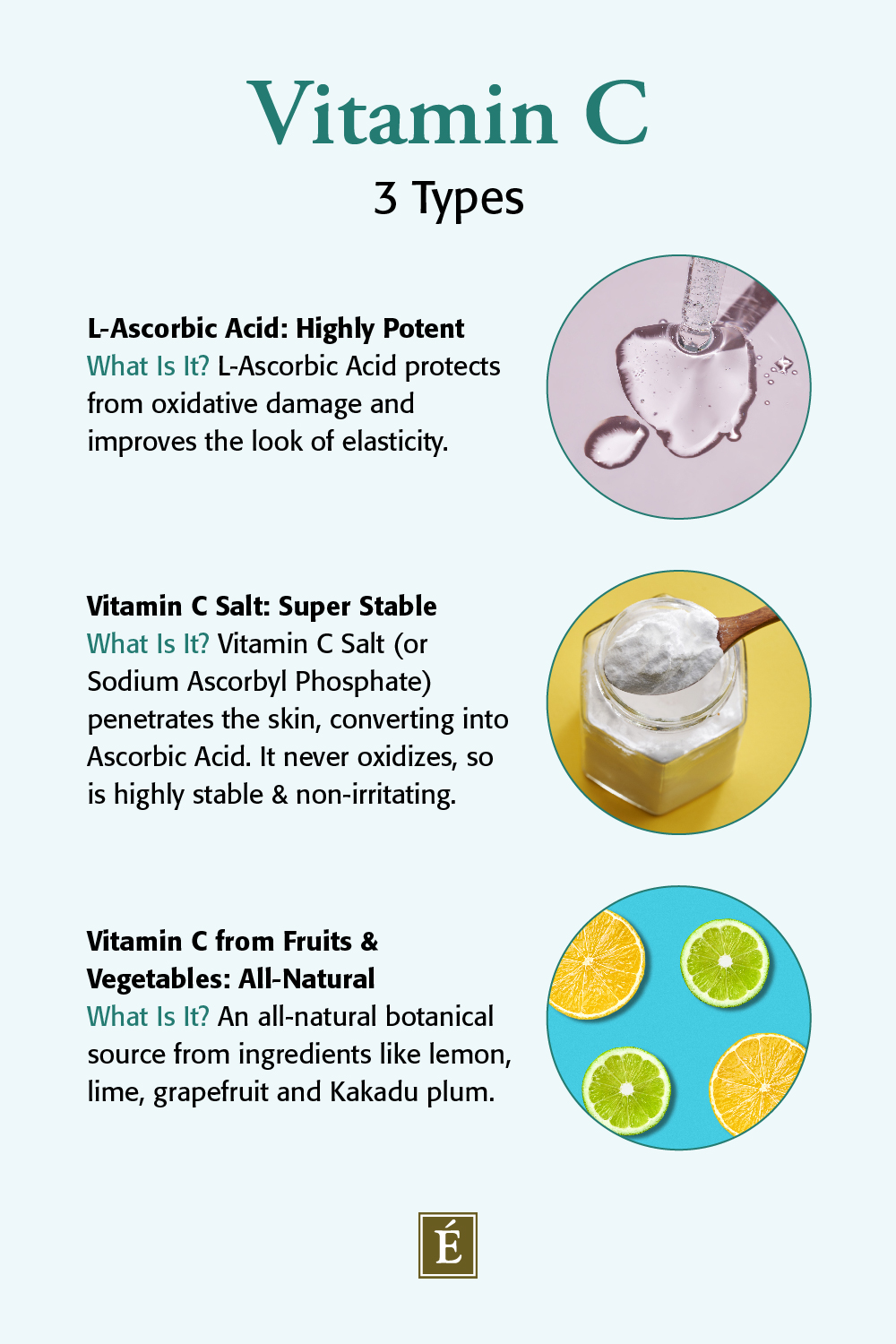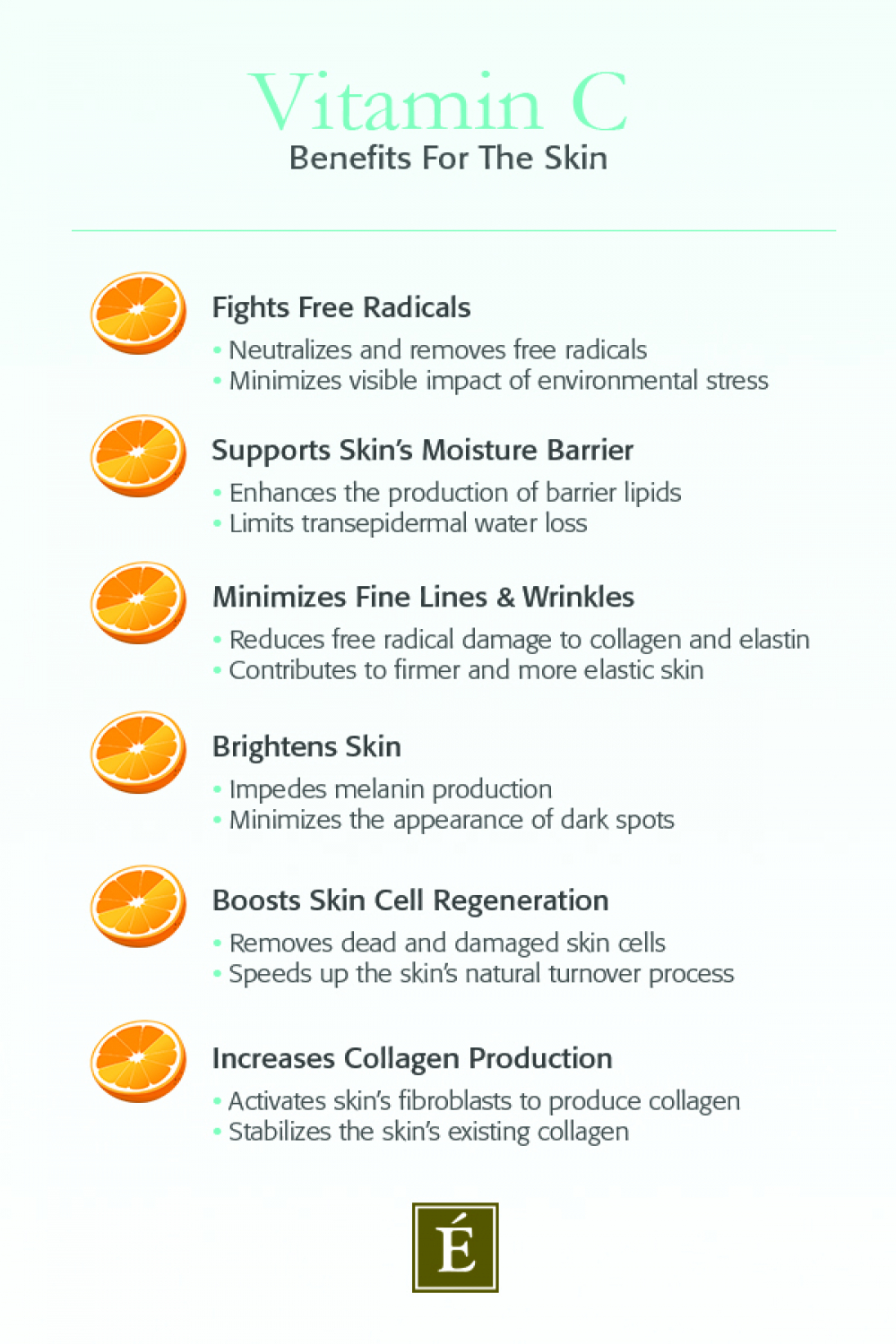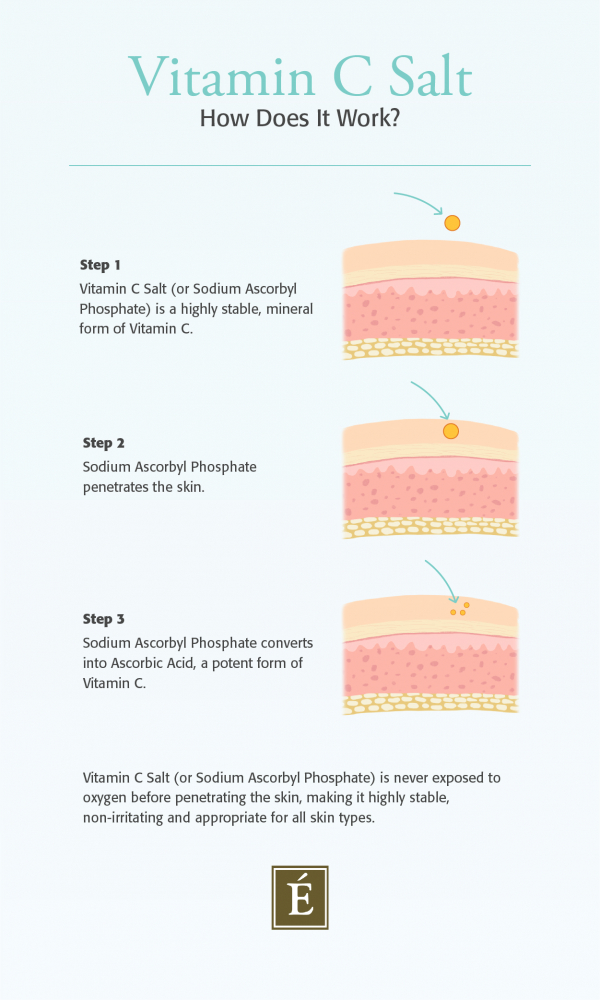
It’s no secret that Vitamin C is a skin care superstar. This powerhouse ingredient is celebrated for its ability to deliver a brighter complexion, even out skin tone and diminish the appearance of fine lines and wrinkles. Here’s everything you need to know about Vitamin C and how to add it to your skin care routine.
What Is Vitamin C?
First things first: What exactly is Vitamin C? Also known as ascorbic acid, Vitamin C is a potent antioxidant that is necessary for the growth, development and repair of all body tissues — including the skin. As Eminence Organics Lead Skin Care Trainer Natalie Pergar tells us: “Vitamin C is an incredibly effective nutrient for your body and an all-around savior for skin care. It’s been found to help prevent UV damage, reduce pigmentation, reduce inflammation and boost collagen production in skin.” We cannot produce Vitamin C and our bodies don’t store it; therefore, we can only receive its benefits by ingesting it (think chewable vitamins and freshly-squeezed orange juice) or by applying it topically (cue Vitamin C in your favorite skin care serums and moisturizers). Popular sources of Vitamin C include:
Citrus fruits such as lemon, orange and grapefruit
Leafy greens such as kale, broccoli and spinach
Tomatoes
Strawberries
Rosehip oil
Seabuckthorn oil
Kakadu plum
You might think that oranges has the highest concentration of Vitamin C, but surprisingly, Kakadu plum has 30 to 50 times the amount of Vitamin C in comparison. Eating this superfruit or applying it topically may potentially aid in reducing the appearance of dark spots, enhancing skin radiance and minimizing the appearance of wrinkles. You can read this guide on superfoods for skin for more information.

Vitamin C Benefits For Skin
The benefits of Vitamin C for the skin are seemingly endless. One of its most important features is that it is able to mitigate skin problems before (and even after) they occur. According to Natalie: “One of the great things about Vitamin C is it both helps prevent and repair damage caused by our environment.” During the day, Vitamin C can provide additional protection against the aging effects of environmental stressors such as pollution, blue light and UV rays; at night, its rejuvenating properties can minimize the look of damage caused by free radical exposure. Here’s a closer look at Vitamin C’s many skin care benefits.
Fights Free Radicals
Heidi Waldorf, MD describes free radicals as “anti-oxygen bombs that trigger inflammation and cascades of damage”. These highly unstable molecules are missing an electron and, in an attempt to stabilize, steal electrons from otherwise healthy cells. This type of attack changes cell composition and triggers oxidative damage that presents as dryness, irritation and premature aging.
How can free radicals be stopped? Neutralize the “bomb” so to speak. Antioxidants donate an electron to free radicals before they can cause undue damage to the skin. Vitamin C is one such antioxidant that can neutralize and remove free radicals, thereby minimizing the visible impact of exposure to pollution, particulate matter and other types of environmental stress.
Supports Skin’s Barrier Function
One of the ways Vitamin C benefits overall skin health is by supporting the skin’s barrier function. The lipid barrier is an essential part of the skin’s outer layer and is often likened to mortar, holding together the bricks that are your skin cells. When healthy, it acts like your skin’s security guard: It keeps in the good by helping skin retain moisture and keeps out the bad by denying potential irritants (like troublesome free radicals). Studies show that Vitamin C enhances the production of barrier lipids and, by extension, the skin’s ability to protect itself from transepidermal water loss, keeping it healthy, happy and hydrated.
Minimizes Fine Lines & Wrinkles
Collagen and elastin are frequent victims of free radical damage. These structural proteins are responsible for the density and bounce associated with a youthful complexion. When weakened, they are unable to provide much-needed structural support and, as a result, the visible signs of aging (including sagging skin and fine lines and wrinkles) begin to develop.
As an antioxidant, Vitamin C helps stave off the visible signs of aging caused by free radical damage. In fact, a 2007 study by the American Journal Of Clinical Nutrition found that women aged 40-74 who consumed high levels of Vitamin C appeared to have fewer fine lines and wrinkles and less overall dryness in their skin.

Brightens Skin
Vitamin C’s antioxidant quality can also minimize the appearance of hyperpigmentation. When faced with stress, the skin defends itself by triggering cells called melanocytes to produce the pigment melanin. Vitamin C inhibits the function of tyrosinase, the enzyme that activates the skin’s melanocytes, thereby impeding melanin production and minimizing the appearance of dark spots and hyperpigmentation. This contributes to a brighter and more even-toned complexion.
Boosts Skin Cell Regeneration
Skin cell turnover is the process by which dead cells are shed from the skin’s top layer and new, fresh cells rise to the surface. One feature of healthy skin is its ability to efficiently turn over, a process that slows with age. With its acidic nature, Vitamin C is helpful in sloughing away dead and damaged skin cells, thereby speeding up the skin’s natural turnover process. This not only smooths skin texture, but also reduces dullness and minimizes the look of dark spots and hyperpigmentation.
Increases Collagen Production
In addition to extrinsic factors (like environmental stress), intrinsic — or biological — aging contributes to the decline of collagen. As you age, your skin’s stores of collagen naturally deplete and degrade, resulting in the visible signs of aging. Vitamin C not only activates the skin’s fibroblasts to produce new collagen, but it also stabilizes the collagen you already have, helping skin stay firm, plump and youthful-looking for longer.
Watch this In The Mix video where Natalie outlines how Vitamin C may reverse the visible signs of aging: :
How To Use A Vitamin C Serum
Natalie tells us: “Vitamin C is essential in everyone’s routine. Your body doesn’t make this vitamin, so the only way to obtain its benefits is to apply it topically.” One of the best delivery vehicles for Vitamin C to the skin is a serum. Here’s how to use a Vitamin C serum in your skin care routine.
Perform A Patch Test
If you have sensitive skin, we recommend performing a patch test before adding a new ingredient to your skin care routine. Follow these steps with a licensed esthetician at your favorite Eminence Organics Spa Partner:
Select a small area of skin that can be easily concealed (like your forearm or behind your ear).
Apply a small amount of product and wait 24 hours.
If no side effects occur, apply to your face. Discontinue use if you experience any discomfort such as a rash, redness or hives.
Add A Vitamin C Serum To Your Skin Care Routine
Adding a Vitamin C serum to your skin care routine is simple. Vitamin C is typically formulated in a fast-absorbing formula, suitable for all skin types that can be used both morning and night. Skin care experts recommend applying 1-2 drops of serum to cleansed and toned skin. Use your fingers to spread a thin layer of serum over your face and neck, then wait for it to completely absorb before applying your favorite facial oil and/or moisturizer.
Watch this video to learn from Natalie about how you can add Vitamin C into your skin care routine: :
What To Look For In A Vitamin C Serum
When choosing a Vitamin C serum, there are a few things to keep in mind. Pick a serum with:
L-ascorbic acid (the most potent and effective variety of Vitamin C in skin care).
A concentration of 10-20%. Below 10% may not be sufficiently potent and above 20% can be too powerful for most skin types.
Complementary ingredients like Vitamin E and ferulic acid enhance Vitamin C’s antioxidant properties and keep the formula stabilized.
Citrus & Kale Potent C+E Serum
Our Citrus & Kale Potent C+E Serum is a lightweight formula that can easily be added to any skin care routine. This serum is formulated with Vitamin E and ferulic acid which, as mentioned, enhances its antioxidant properties and helps to retain its potency. This formula also includes three varieties of Vitamin C. First, there’s L-ascorbic acid, a powerful form of the antioxidant. Second, you can find Vitamin C from natural sources — citrus fruits like lemon and orange and leafy greens like kale and broccoli. And third, the serum contains sodium ascorbyl phosphate (also known as Vitamin C salt) which is illustrated below.
Pro Tip: Enhance your routine with the Rosehip Triple C+E Firming Oil and Citrus & Kale Potent C+E Masque. The hydrating qualities of these complementary products add essential moisture and encourage the skin to absorb more Vitamin C over time, thereby enhancing the efficacy of the serum.

Why Vitamin C & E Together?
There’s a reason we combine Vitamin C, Vitamin E and ferulic acid. Natalie says: “Together, these ingredients provide additional protection against free radicals to further reduce the appearance of damage so skin stays healthy-looking, smooth and luminous.” According to Mindbodygreen, one study found that these two ingredients increase Vitamin’s C effectiveness eightfold! As well as boosting potency, the addition of Vitamin E and ferulic acid helps to stabilize Vitamin C, which is a notoriously finicky ingredient.
How To Store Vitamin C & Keep It Stable
Vitamin C is a vulnerable ingredient that will break down if it is routinely exposed to air and light. Unless protected, it rapidly degrades and oxidizes, losing its antioxidant benefits. In addition to choosing a serum that is packaged in an opaque, air-restrictive bottle, store your Vitamin C serum in a cool, dark place to keep it away from sunlight. You can even go as far as storing it in the fridge to keep it fresh for longer.
Understanding the properties of Vitamin C for the skin, and how to store it for long-term use, can be linked back to the research of a small group of scientists. In particular, it was one Hungarian scientist who made some very important discoveries in the 1920s and 30s, as you’ll read next.
The History Of Vitamin C
The isolation and identification of Vitamin C was one of the most important discoveries in the 20th century, leading to dramatic improvements in human nutrition. Scurvy was among many diseases suffered due to malnutrition. According to research, it was a common problem in the world’s navies during the 18th century and is estimated to have affected 2 million sailors. Symptoms included fever, swollen and bleeding gums, and delirium and pain in the limbs.
It’s reported that in 1928, the Hungarian research team consisting of Albert Szent-Györgyi and Joseph L. Svirbely isolated a substance from adrenal glands that they called hexuronic acid, and later renamed ascorbic acid, or Vitamin C.
The new name ascorbic acid is derived from scorbuticus (the Latin name for scurvy), since a lack of this molecule may lead to scurvy in humans and other animals. In 1937, Szent-Györgyi won a Nobel Prize in medicine for both the discovery of Vitamin C and the description of oxidation, becoming a Hungarian national hero.
Are you ready to add a Vitamin C serum to your skin care routine? Visit an Eminence Organics Spa Partner to learn more about how this classic ingredient can benefit your skin.
This article was originally written in August 2019.
